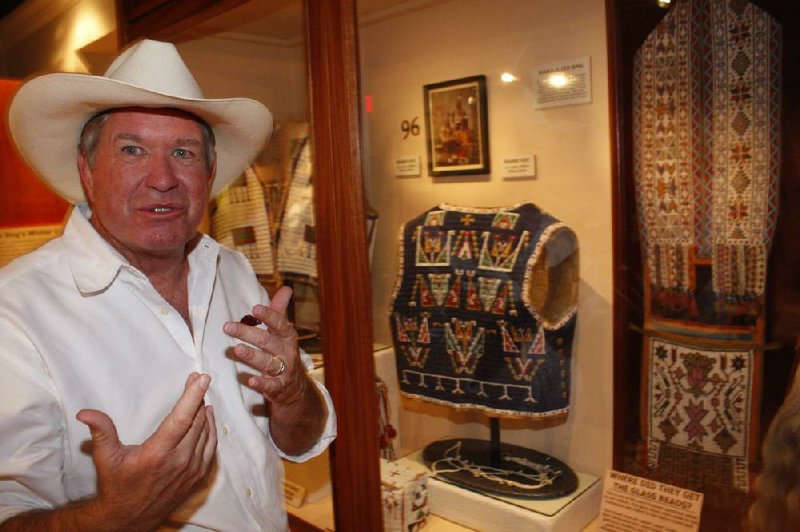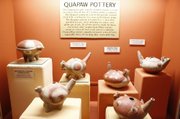BENTONVILLE — Folks who grew up in the state’s 10th biggest city are quick to point out a gated community or satellite office for the likes of Budweiser or Nestle and tell you when it was a sharecropper’s field a generation ago. More than any other in Arkansas, this city was a very different place then.
Today, it lives for the present and the future. The airport. The world’s biggest retailer. Even Sam Walton’s five-and-dime on the old town square is referred to mostly these days as a pillar of the tourism circuit.
Last fall the talk of the town - indeed, the nation - was the opening of Crystal Bridges Museum of American Art, daughter Alice Walton’s multi-billion dollar grotto to America’s heritage painters and artists. But it was a follow-up - and a far shallower one for chronology - to another Wal-Mart inheritor and his museum of America’s past.
At about one 33rd the size, David Bogle’s Museum of Native American History is a sinewy diorama of our Indian predecessors’ tools and crafts. Bogle, whose father, Bob, was one of Walton’s first store managers and is credited with naming the chain, opened the museum five years ago.
Its greatest volume of artifacts is stone-chiseled cutting instruments such as serrated edge hand tools, spear tips and arrowheads, but it’s slowly expanding into near-historical goods. In November, Bogle putout the 19th-century medicine chest of one Moses Decorah, healer of the Indians in Buffalo Bill Cody’s Wild West Show.
CREATOR, CURATOR, DOCENT
Upon entering, your attention is steered immediately left to a dead-end and a life-size cast of a mastodon skull with the heft of a wrecking ball. From there, you can pick up a self-guided audio tour wand - it resembles a remote control - and snake through the museum, from paleo-Indian arrowheads dated12,000 to 8,500 B.C., to well preserved effigy pots of the late-prehistoric (before the 17th century) Caddo, Quapaw and Mississippian tribes.
“My goal here is to make people understand that not all Indians were sitting on spotted ponies and wearing headdresses,” Bogle said.
Only the final quarter of the museum is given over to recorded history and the kinds of artifacts Americans of all backgrounds have come to view as Indian - feather headdresses, beaded vestments and slippers, folk art.
Most of the museum pieces are Bogle’s own or on loan from the University of Arkansas. The rest are on loan from collectors such as Dr. Kent Westbrook of Little Rock.
Likewise, while Bogle solicited the help of University of Arkansas museum designer Bob Winkleman and artist Kelly Green, most of the staging is his own concept.
The end result is an institution registered as a nonprofit with all the tax breaks pursuant to that designation; but Bogle applied for no federal or state grants to operate the Museum of Native American History (MONAH), and he spends none of his budget on advertising. He balances the books from “private donations,” by which he means the munificence of a single zealous investor, by which he means David Bogle.
“Are you a docent or someone who works at the museum?” asked Letresha Davis, a Bakersfield, Calif., resident.
“I am,” obliged Bogle.
“What are those itty-bitty arrowheads for?”
Bogle is genuinely delighted to answer even the most indecorous questions - provided they don’t include the words “cost” or “paid” or “on the market” - and when he discovered Davis’ Indian lineage (Cherokee and Choctaw) he gave her a brief guided tour of exhibits specific to her heritage.
THIS AMERICAN INDIAN LIFE
As for marketing, the online review site TripAdvisor.com ranks the museum its best of four tourist destinations in Bentonville - better than Crystal Bridges, better than the Wal-Mart Visitors Center and better than the historic Peel Mansion and Gardens. Not one of the amateur reviews mentions any limits- real or perceived - of the picture of American Indian life and culture painted by these artifacts. Most say the collection is extraordinarily far-reaching.
But how much can a couple of thousand arrowheads tell us about the earliest Arkansans?
Not much, says Westbrook, a collector for more than half a century, who has loaned the museum several key pieces including The Screaming Quapaw.
“The objects that they made, the pottery objects, show a real sophistication in their appreciation of beauty and symmetry and completeness in an individual object, but you never know,” he says. “They never had any written language. We’ll never know what they thought, and the only way to approach what they thought is through the art.”
One regular decorative motif is “the swirl.” At times a concentric vortex, at others a barbershop pinwheel, the white stripe was made with an ivory clay slip while the red is almost sienna. It “shows up everywhere,” Westbrook says.
“What does it mean? I don’t know. Does it mean the winds? Does it mean the physical and the spiritual, above and below? I don’t know. I know it had a very important meaning to them.”
Early in the walking tour, a wall mural and artifacts explain the atlatl, a lever-action spear chuck that leveraged handle length like a golf driver to send a shortened spear farther, faster than it could ever sail when flung by the unassisted human arm. Anyone can see the ingenuity of this device and its importance among the people of the time.
“David has started expanding [to] beadwork from the Midwest, Navaho blankets and rugs from the Southwest,” Westbrook says. “So he has expanded beyond the Arkansas region, [and] not all of it’s been displayed in public museums before.”
A FRAGILE COMPROMISE
Not everyone is thrilled with Bogle’s reputed altruism.
“I won’t go in there,” says Carrie Wilson.
Wilson is program director for Native American Graves Protection and Repatriation Act for the Osage and Quapaw tribes, and the daughter of famed artist Charles Banks Wilson.
“There’s things from the Quapaw over there that they did not get permission from the Quapaw to be exhibited there. He’s a collector, not a museum person,” she said.
The chairman of the Quapaw Tribe, John Berrey, repeated several times that he’s not familiar with the specific pots on display at MONAH, although he has visited the museum and “it does a nice story about the Quapaw tribe and our history in Arkansas.”
The region is full of pots and artifacts, he said, and the tribe has its own collection of nice pieces curated and kept at the Arkansas Archeological Survey.
Still, he said that all of the pottery that can be “attributed” to the Quapaw should be returned to the Quapaw.
“Whatever we decide to do with them would be based on some thought and discussion. That would be our stance on outstanding Quapaw pottery. But I don’t have a legal leg to stand on, unless I could use the [Native American Graves Protection and Repatriation Act] to go through the repatriation process, which is what Carrie Wilson does for the tribe, and she’s been very successful.”
Bogle says he has never had any contact with the Quapaw on the matter, and that artifact repatriation through the act might be in order “if I were an institution that receives state or federal funding.”
He also said that he has returned artifacts in the past. A particular collection of Caddo pieces unearthed by archaeologist Gregory Perino came with very detailed site notes that indicated they were from a burial, “and I just decided I would return them.”
TRAGEDY AT SPIRO
In general, Bogle doesn’t disclose from where or for how much he acquires his display pieces. He acknowledges in one prominent corner of the great exhibit room that Oklahoma’s Spiro Mounds were desecrated.
In the 1930s, the Pocola Mining Co. unearthed there a vast network of burial grounds, tombs for powerful Indian leaders from A.D. 850 to 1450, men buried with elaborate ceremony and grave pieces such as feather robes. In short order, artifact hunters looted the graves, shuffling and spoiling the human remains and fragile materials in favor of stone and metal objects with predictable market value.
When they lost their “mining” lease, the treasure hunters set off dynamite inside the chambers.
“That would never take place today the way that they were back then,” Bogle says. “Today we would simply consider it looting. It was almost a tragedy - it was a tragedy what happened to Spiro.”
On the other hand, “The University of Arkansas has been able to acquire many of those artifacts, and so we’re very lucky.”
And the man at the university most responsible for that was Sam Dellinger (1892-1973).
Dellinger built the UA museum’s collection beginning in the 1920s. He was fairly consumed with Indian artifacts at the time of the Spiro Mounds disaster, and he’s credited with bringing many of the looted artifacts into the sanctuary of the university’s collection.
“Certainly from a modern museum ethics perspective, but even within accepted ethical principles of museums in the 1930s, Dellinger’s decision to accept objects that originally had been purchased from individuals involved in looting the Spiro site was questionable,” wrote Robert Mainfort in his biography of Dellinger, Raiders of the Lost Arkansas.
So it would seem nearly every exhibition or collection of American Indian artifacts would present such a moral dichotomy - to exhibit or not to exhibit significant artifacts brought to the surface by grave robbers.
Tom Green, director of the Arkansas Archeologoical Survey, would broaden it further.
“Looting archaeological sites around the world is a major occupation for lots of people, in all time periods. Civil War sites. Colonial graveyards. People will loot graves just looking for anything.”
Until 1991, the state of Arkansas had no prohibition against digging up sites on private lands, but that year the state Legislature passed Act 753, in large measure motivated by the federal Native American Graves Protection and Repatriation Act passed just a few months earlier in late 1990.
That law calls for institutions that receive federal funds to return relics to their respective tribes.
But Bogle doesn’t receive federal funding.
“While we’re not required to get permission, I do work with the tribes, especially the Caddo tribe where we have so many pieces from,” he said, “and I’ve actually returned pieces from my own collection that I was able to determine exactly what site they came from.”
PAST AND PRESENT
“Since the closing of the university museum exhibit hall [in 2003], what he’s created is one of the only places people can view prehistoric Native American objects,” Mainfort said.
Like the university, it’s completely free. And the parking’s better.
“I mean, it’s beautiful,” said Velencia Waggle, who traveled with her husband from Vancleave, Miss., and camped at Hickory Creek. “We came to go to Crystal Bridges, but this is beautiful. I don’t think I’ve ever seen so many arrowheads and vessels in one place.”
Westbrook has been monitoring Bogle’s work as a collector and curator since his earliest displays, back at his home a few blocks from Walton’s five-and-dime.
“People living today need to appreciate that there have been people in Arkansas for 10,000 years, and those people developed some pretty sophisticated tools and art objects - intelligent people with sophisticated societies even if we don’t know everything about them,” Westbrook says.
“I’ve visited his collection when it was in his house, in the previous museum, and this one. I’ve probably been through it eight or 10 times. I try and go through there once a year because it changes every time. He’s continually updating and expanding and improving.”
Style, Pages 51 on 09/23/2012


